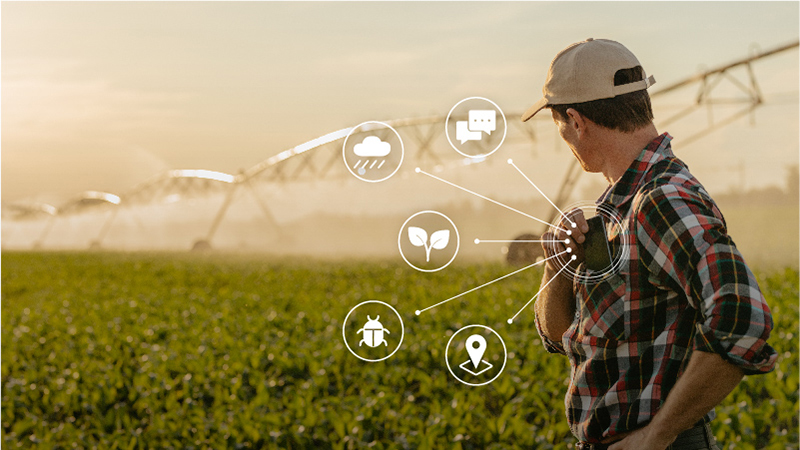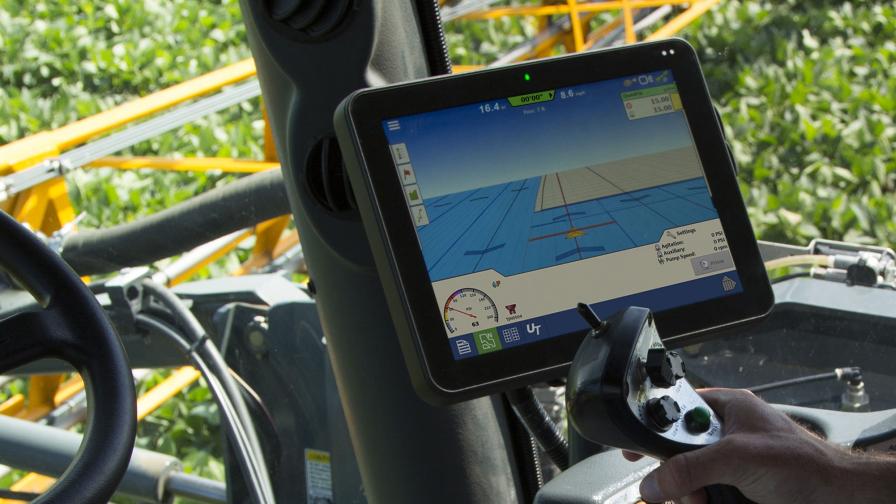Rate Controllers: In the Interest of Interconnectivity
Harmony remains one of the most pressing issues today among the makers of rate controllers. As much as one manufacturer would like to outdo its competitors, it realizes the nature of the business could (and should) produce strange bedfellows.
“Like it or not, all of our end users do not buy the same field computers,” Don Keller, Self-Propelled Sprayers Marketing Manager, New Holland, says. “If you want a customer to embrace your technology, then that technology must be able to operate with other company systems.”
Such interconnectivity is “very important,” Keller says. Growers must easily be able to transfer data from one brand of field computer to another and then be able to transfer that information to the office, he says.
ISOBUS compatibility, the international communication protocol that first broached the agriculture industry in 2008, still poses one of the “biggest challenges” for Raven Industries, the company’s Director of Sales and Marketing, Ryan Molitor, says.
“Often times (our customers) already have a virtual or universal terminal in the cab, which could be Raven or it could be a different brand,” Molitor says. “Our end customers like the ability to use what they already have, especially if it is controlling other functions on the machine.”
David Webster, Director of Application Equipment Marketing, AGCO, stresses the importance of not only interconnectivity among multiple brands of machines and farm management information systems but also compatibility with different map types required by different controllers. “One of the biggest issues our industry faces related to rate controllers,” Webster says, “is communication, specifically data transfer to and from the rate controller — whether it is communicating a prescription map to the controller or as-applied data back to the office to drive billing; or allowing the data to be used as another layer in helping drive decisions.”
According to Mark Burns, Application Equipment Marketing Manager, Case IH, the goal for users is “complete machine control.”
“They aren’t only looking for product application. They also want interfacing with the other precision technology available to them, with all access in one place,” Burns says. “A true solution for today’s operators provides access to rate control, section control, spray technology, and guidance in the same place they can find their vehicle operation information and run screens.”
Another issue that has arisen for growers, Molitor says, is a lack of scalability and flexibility for rate controllers to do more beyond simple single-product control. “Some rate controllers may only do liquid or may only do granular,” he says, “whereas you can take the Raven Rate Control Module … and customers will have the ability to utilize five products: liquid, granular, NH3, air seeder, and some planter functions as well.”
The bottom line with rate controllers is the grower’s financial bottom line, says Brady Bjornson, Product Manager, Topcon Precision Agriculture. And yield optimization starts with rate controllers applying crop inputs, he adds.
“Growers are business owners the same as they are technical experts in growing crops. The rate controller that a grower uses in his or her operation sets the tone for input efficacy and optimizing profitable yield,” Bjornson says. “In today’s economic climate, optimizing fixed costs with accurate and capable rate controllers to put the right product, at the right place, at the right time, and at the right rate is paramount in achieving operational profitability. Waste is not an option with razor thin margins.”
Adds Keller: “If you, as an owner and/or operator, have not yet embraced this technology, you are making your job a lot more difficult than it needs to be. You are leaving money in the field from not being as efficient as you can and should be.”
This year has seen more connectivity tools for data recording, operational efficiency, and logistics, Chad Swindoll, Precision Technology Agronomist, Ag Leader, says. His company recently announced two new features to its AgFiniti connected platform — live stats and prescriptions.
Pertaining to application, live stats allows connectivity across all devices in the operation. For example, a smartphone or tablet in the tender truck can display the applicator’s application rate, speed, location, and container level while the applicator can see the tender truck location, speed, and direction of travel. Meanwhile, prescriptions within AgFiniti are based on fertility recommendations from trusted universities, Swindoll says. “Customers can tailor recommendations on grain harvest data, bushels removed, and soil sample data.
Prescriptions are sold on an affordable per-acre basis and allow for any additional prescriptions to be generated for one year, he says. “Conveniently, customers can get prescriptions right away from any web-enabled device.”
The “big push” next year, according to Topcon’s Bjornson, will be multi-variety planting. “High-speed planting has not really taken off as the vast majority of growers are still looking to maintain their existing planting speeds (while) looking to increase planting quality,” he says. “Acres are hard to come by, or it’s not financially feasible to pick up more acres at existing land values. Therefore, operators are looking to do more with what they have. I feel seed reps and agronomists understand a lot better now how they can integrate multiple varieties into a field through defensive and offensive traits, pending soil makeup, moisture availability, topography, etc.”
Topcon will launch the Athene spreader ECU, which, Bjornson adds, will improve rate-control accuracy by using load cells to constantly calibrate application on the fly to ensure the right amount of fertilizer gets to where the plant can use it.
Raven will introduce a blockage module system that will pair with the company’s Rate Control Module for use primarily on air seeders, Molitor says. “We are also introducing a new functionality for use with manure spreaders, which we call dynamic calibration. This will dynamically change the density factor based on user-entered values,” he says. “We also have a cleanout feature, which will help control toward the end of a load, ensuring the application rate stays (where) the operator needs it to.”
Product Recognition
• Ag Leader: The company’s DirectCommand liquid system ensures that application rates stay on target by seamlessly transitioning from either flow-based control or pressure feedback, Swindoll says. “Rather than relying on one sensor for control, DirectCommand uses two. Additionally, DirectCommand continually monitors the relationship between expected flow and measured flow to detect failures in the spray system, such as broken hoses, plugged filters, and failing sensors,” he says.
• AGCO: In 2018 the company went into full production of its RoGator C Series applicator, which offers as standard equipment the AgControl rate control system, with up to 36-section control. “With standard e-stop valves and 36-section control, we have valve banks determined by boom size, with varying numbers of nozzles per valve bank,” Webster says. “This allows improved coverage accuracy since there will be fewer nozzles in the outermost boom valve banks, where nozzles more actively move in and out of a sprayed area. The rate controller now uses the calculated boom width, along with agitation and pressure inputs to apply product at an even more precise rate.”
• Case IH: The AFS Pro 700 is a familiar display option for those who run other Case IH products, such as Magnum and Steiger series tractors and Early Riser planters, Burns says. The AFS AccuTurn automated headland-turning technology is available on the high-powered Patriot series sprayers for use with the AFS Pro 700 display.
• New Holland: The IntelliView field computer is a proven technology that gets enhanced every year to keep pace with a constantly changing environment, Keller says. “We are very proud of the fact that we have been on the leading edge of not only field computers for spraying but are also able to use the same monitor and GPS antenna for other equipment on the farm, such as tractors, combines, and forage harvesters just to name a few,” he says.
• Raven Applied Technology: “Don’t settle,” Molitor tells growers. “It’s easy to think that a simple, single product rate control is good enough, but know what your options are and don’t underestimate the value in having a fully scalable solution. There is a lot of innovation in something like the Raven Rate Control Module, and having more precision in your rate controller means better application and efficacy in the field, which will help your profitability.”
• Topcon: “The one thing I would challenge growers to do is to continue to invest in technology products, which make them better growers,” Bjornson says. Products such as the Apollo Sprayer ECU with Hypro ProStop-E automatic section control valves allow a pull-type or self-propelled sprayer to have individual nozzle control to decrease chemical wastage as well as decrease chemical driftability, he adds. “A winning system like this cuts chemical costs and prevents applied growth regulators from stunting crops through excess application.”
As for a take-home message for ag retailers, AGCO’s Webster says they should take advantage of the educational events, including preseason clinics, often hosted by dealers.
“In many instances, operators are not taking full advantage of a rate controller’s capability,” Webster says. “Don’t overlook calibration, whether it is checking for build-up in the flow meter or ensuring the hydraulic pressure that drives the product pump is correct, because these will impact rate attainment and accuracy.”







